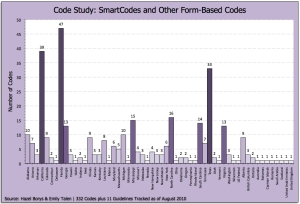A Placemaking Journal
Brave New Codes Reach Tipping Point: When, Where, Why?
A year ago, Apple’s sales of its iPhone and iPod Touch eclipsed 40 million units, confirming their potential to fundamentally retool our future opportunities and patterns of daily life.
Today, a year later, form-based codes hit a similar milestone, with similar implications, as over 330 cities and towns around the world — representing over 40 million people — have embraced the idea of form-based coding as an alternative to the sprawl-inducing zoning models of the past century.
We’ve hit the tipping point. Welcome to the other side.
The understanding has clearly dawned that use-based development codes separating people from their services are not good for us, or for our environment. Euclidean, single-use zoning creates a sense of placelessness in which strip malls, bedroom communities and office parks fragment cities into disconnected sprawling pods accessible via automobile. Here the economy can only be sustained within a series of big boxes — retail, churches, schools, commercial, and recreation. Major fluctuations in the market cycle hit hard within these inflexible development patterns.
We’ve been talking about form-based codes (FBCs) as an alternative to all that here, here, here, and here. And we’re not the only ones talking. Architect Magazine’s Brave New Codes does a great job of laying out the dynamics, particularly from the perspective of architects.

“If the architects could understand that they’re part of a larger effort of placemaking, and it’s not just a restriction like any old code, I think that they would have a good time working with form-based codes,” says Elizabeth Plater-Zyberk. She was the coauthor of the first form based code, adopted in 1986 in Seaside, Florida, and also of the recent adoption of the Miami 21 SmartCode, the largest form-based code effort to date. Within those 25 years, form-based codes have come of age.
To help share the knowledge, the recently-formed Transect Codes Council launched its first TCC News newsletter today. The TCC works to expand the use of open source transect-based codes and modules for planning and regulating the built environment as part of the natural environment. Made up of 18 members, TCC is similar in some ways to the Form-Based Codes Institute (FBCI), but TCC is also an advisory board to the Center for Applied Transect Studies (CATS) and focuses solely on codes that incorporate the rural-to-urban transect as a mechanism for placemaking.
Hitting this tipping point has taken some time. The Codes Study, coauthored by Emily Talen and me, was released this week, detailing the 332 FBCs currently underway along with 11 form-based guidelines. 25 years ago, when this all started, it took some time for the built results to tell if FBCs work, and why. But take a look at the graph of codes adopted over time, and you’ll see that the movement is picking up steam. The reality has sunk in that complete, connected, convivial communities are the most sustainable in the long run. Not to mention the most enjoyable today. And because the unit of coding is the neighborhood, form-based codes apply just as well to big cities as they do to small towns. It’s all about coding the character of the place. Some of the biggest players adopting FBCs include Miami, Denver, Baltimore, Dallas, Houston, San Antonio, Orlando, Phoenix, Lee County Florida, Buffalo, Saudi Arabia, Scotland and the United Arab Emirates.

However, the small town players are making some big impact as well, across the US and Western Canada. The other day I picked up a Skywest Magazine on a United flight, and was happy to see that 14 of the cities and towns showcased in this issue have form-based codes in progress or adopted, including the cover town of Steamboat Springs, Colorado. The headliner article points to the reasons why Steamboat Springs would want a FBC. The code protects both the extraordinary mountain — hiking, skiing, biking, hot springs, kayaking and fishing in the Yampa River — as well as the character-filled mountain hamlet and its art galleries, restaurants and music. It does this by keeping the new development around the town compact and in keeping with the existing character — true to form, you might say. For Steamboat Springs, as well as most of the other 332 form-based codes underway, the new regulations are making peace between the enviros and developers, and keeping it real.
–Hazel Borys










